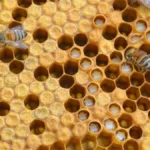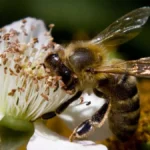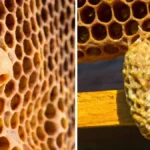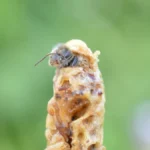We take a look at how to tell the difference between drone brood vs worker brood, and the difference between brood and honey cells. This is an important basic skill for beekeepers and there is some humor involved in mistakes around this identification.
A Humorous Example Of Why It Is Important To Know The Difference Between Brood and Honey Cells
When I was younger I used to do at least 50 bee removals every year. This involved removing bees from walls and ceilings mostly. These days I mainly just collect swarms. When we remove wild bee nests there is normally a lot of bee brood. In my area, we have a lot of hive beetles, and during the process of removing a swarm, the beetles often manage to lay eggs in the brood. I consequently do not keep the brood. It becomes chicken food.
For bee removals, I normally have a few buckets and the brood comb goes into a few buckets. Old brown combs containing pollen and honey go into another bucket and I use that to make mead. If there is any nice white or yellow comb I keep that aside and give some to the house owner and the rest is for gifts.
I remember I had this horrible man, who refused to pay me because I had got so much “honey” out of the hive. I had three buckets of the brood. He figured he would show me, and grabbed a comb of brood and bit into it. I can still see the look on his face as his mouth filled with salty creamy bee juice. I then explained to him that he had just eaten a mouthful of bee larvae. He opened his wallet and paid me for the removal and walked away without saying a word. I still chuckle when I see him to this day.
Drone Brood vs Worker Brood
Drone brood is very easy to see – the cells are larger than worker cells, and the capped brood bulges out like a half peanut from the frames. Worker brood has an orange fluffy capping and drone brood is even more fluffy. You can normally see some larvae in cells in between the capped brood. There will be a few drones emerging – chewing through the capping and waving their antennae around like the big clumsy morons they are.
Learn more about: Queen Cup Vs Queen Cell
Worker brood is flat-capped. The brood has a leathery texture when capped, and you can normally see a few larvae in the brood. If you are uncertain, use a small knife to uncap a few cells and look inside. If it is honey, it is honey – if it is a larva it is brood.
Brood is lighter in weight than honey. Brood combs are also warmer than honeycombs. You will also normally find that brood combs are a bit thinner than honeycombs. Often the bees have a honey crown at the top of a brood comb – you will see the difference.
The Difference Between Brood and Honey Cells
Bees will store honey in both worker and drone cells. When they store honey in a cell they build a wax cap that is flat across the top of the cell. This waxcap is there to keep moisture out of the honey. Beeswax has a greasy look when it has honey behind it. If the honey is white wax, it will look golden when it contains honey.
Bees can make two types of honeycomb capping. If they build the wax flat against the honey, it is a so-called “greasy comb” or “dark capping” or many other names depending on what part of the world you are in. If the bees trap a bubble of air under the capping it is a white comb. This comb looks lighter and has a white color.
Brood cells, unlike honey cells, have a leathery cover over them, as the brood needs to be able to breathe. As we mentioned earlier, worker brood is relatively flat-capped, and drone brood has bulging caps.

Read more about: What Does Capped Brood Look Like?
A Closer Look At Drone Brood
Drone brood cells are big. Worker brood cells typically range from 4.6mm (Apis mellifera capensis) to 5.1mm for European Honeybee races. Drone brood cells are in the 8.4mm cell diameter range, so they are much much bigger.
You can see drone cells without even trying very hard – they are just big. The bees also make a bit of a mess when they try to transition from worker brood cell sizes to drone cells as the geometry of transitioning from small hexagons to large hexagons is complex.
Drone brood is very nutritious. A drone is basically a big flying genital with eyes. A very large percentage of the mass of a drone is this part of it. Drone brood is consumed by many cultures as an aphrodisiac with remarkable results.
Drones take longer to develop because they are so big. As a result, the varroa mite loves drones. You can control varroa mites by placing drone brood combs in the middle of the brood nest and then letting the bees raise a lot of drones. Varroa is mopped up by the drone brood.
Once the drone brood is capped, feed it to your chickens or fry it with a little garlic, butter, and balsamic vinegar as a light healthy snack. The drone brood tastes just like small shrimp. The varroa vanishes – or maybe gets muddled up with pepper grains.
Worker Brood
Worker brood is far smaller than drone brood, as mentioned above. These bees hatch and leave a layer of silk behind, meaning that with time, brood cells build up a layer of silk. This bee silk makes the combs black and strong.
With time, the dark color of the worker brood combs makes it easier to distinguish them. Worker brood is also highly nutritious but when comparing drone brood vs worker brood the nutritional contents are very different.
Worker brood appears to have a beneficial effect on endocrine stability and can be consumed as a snack as well. Fried or in a soup, it adds a pleasant taste to a meal similar to adding coconut milk.
The beeswax wrecks your dishwasher, and it is necessary to rinse cookware with hot water prior to placing it in the dishwasher. Should you foul the dishwasher, use a caustic soda rinse to clear out the beeswax. Beeswax is turned into soap when reacted with caustic soda.
I hope this article has helped you tell the difference between brood and honey cells and drone brood vs worker brood. If you enjoyed this share widely.
Drone Vs Worker Brood FAQs
What is the difference between drone brood and worker brood?
Drone brood consists of larger cells with bulging caps, while worker brood is smaller and flat-capped. Drones are male bees, while workers are sterile females.
Why is it important to distinguish between brood and honey cells?
Honey cells are capped with a flat, greasy-looking layer, while brood cells have a leathery texture. Misidentifying them can lead to mistakes, especially during hive inspections.
How can I tell if a cell contains honey or brood?
Brood cells are warmer and lighter than honey cells. You can uncap a few cells—if it contains larvae, it’s brood; if it’s filled with honey, it’s a honey cell.
How do bees transition from worker to drone cells?
The transition from worker brood to drone brood can look messy because the bees struggle to change from smaller to larger hexagonal cell sizes, creating irregular comb areas.
Why do varroa mites prefer drone brood?
Varroa mites are drawn to drone brood because drones take longer to develop, giving mites more time to reproduce. Using drone brood can help control mite populations.
Can drone brood be consumed by humans?
Yes, drone brood is nutritious and can be eaten. It tastes similar to shrimp and is consumed in some cultures for its health benefits, including potential aphrodisiac properties.
What does capped drone brood look like?
Capped drone brood appears larger, with a raised, peanut-like cap. Worker brood, on the other hand, has a flatter and more leathery cap.
How does brood comb become dark over time?
As worker brood develops and hatches, they leave behind layers of silk in the cells. Over time, this silk accumulation darkens the brood comb, making it appear almost black.
What are the nutritional differences between drone and worker brood?
Drone brood contains higher fat content due to the drone’s reproductive role, while worker brood has more balanced nutrients beneficial for overall health, including endocrine stability.
What should beekeepers do with excess brood comb?
Beekeepers often discard excess brood comb, especially in cases of mite infestations. It can also be fed to chickens or used in cooking, though beeswax can damage kitchen equipment.

Dr. Garth A. Cambray is a Canadian/South African entrepreneur and beekeeper with 28 years of experience in apiculture and specializes in adding value to honey. His Ph.D. research developed a new advanced continuous fermentation method for making mead that has resulted in a number of companies globally being able to access markets for mead. His company, Makana Meadery, exports honey mead to the USA where it is available to discerning connoisseurs. He has also developed technologies to commercially manufacture organic honey vinegar in Zambia for export globally. He holds a few patents globally in the ethanol industry and believes in technology and knowledge transfer for human development and environmental sustainability. One of his proudest achievements is the fact that the wind farm he started at one of his old apiary sites has essentially made his hometown carbon neutral.






